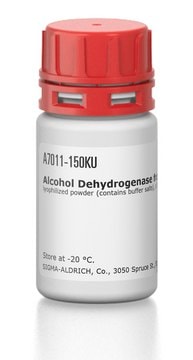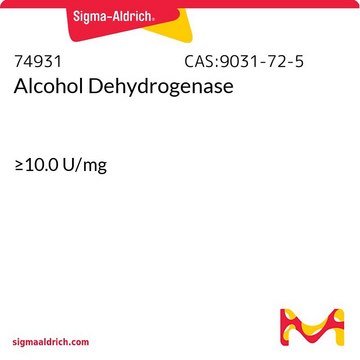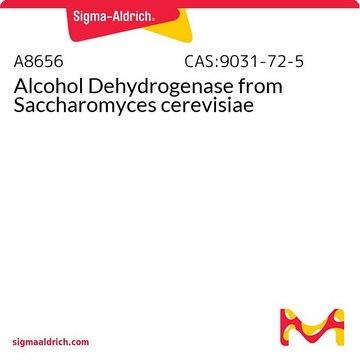55689
Alkoholdehydrogenase equine
recombinant, expressed in E. coli, ≥0.5 U/mg
Synonym(e):
ADH
About This Item
Empfohlene Produkte
Biologische Quelle
equine
Qualitätsniveau
Rekombinant
expressed in E. coli
Beschreibung
Isozyme E sequence
Form
lyophilized powder
Spezifische Aktivität
≥0.5 U/mg
Farbe
white
light yellow
pH-Wert
7
Löslichkeit
water: 5 mg/mL
Anwendung(en)
life science and biopharma
Lagertemp.
−20°C
Angaben zum Gen
equine ... ADH1(111772995)
Suchen Sie nach ähnlichen Produkten? Aufrufen Leitfaden zum Produktvergleich
Allgemeine Beschreibung
Alcohol dehydrogenase is a zinc metalloprotein that forms five classes of isoenzymes through the dimerization of eight different subunits.
Anwendung
Biochem./physiol. Wirkung
Einheitendefinition
Signalwort
Danger
H-Sätze
P-Sätze
Gefahreneinstufungen
Resp. Sens. 1
Lagerklassenschlüssel
11 - Combustible Solids
WGK
WGK 1
Flammpunkt (°F)
Not applicable
Flammpunkt (°C)
Not applicable
Analysenzertifikate (COA)
Suchen Sie nach Analysenzertifikate (COA), indem Sie die Lot-/Chargennummer des Produkts eingeben. Lot- und Chargennummern sind auf dem Produktetikett hinter den Wörtern ‘Lot’ oder ‘Batch’ (Lot oder Charge) zu finden.
Besitzen Sie dieses Produkt bereits?
In der Dokumentenbibliothek finden Sie die Dokumentation zu den Produkten, die Sie kürzlich erworben haben.
Unser Team von Wissenschaftlern verfügt über Erfahrung in allen Forschungsbereichen einschließlich Life Science, Materialwissenschaften, chemischer Synthese, Chromatographie, Analytik und vielen mehr..
Setzen Sie sich mit dem technischen Dienst in Verbindung.








